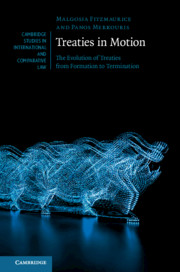90 results
3 - The New Generation of Environmental Non-Compliance Procedures and the Question of Legitimacy
- from Part I - General and Conceptual Issues
-
-
- Book:
- International Courts versus Non-Compliance Mechanisms
- Published online:
- 15 February 2024
- Print publication:
- 22 February 2024, pp 49-70
-
- Chapter
-
- You have access
- Open access
- HTML
- Export citation
6 - Legitimacy in Settlement of Disputes in International Environmental Law: From Classical to Non-compliance Procedures
- from Part II - Effectiveness, Authority, and Legitimacy of the Current System of International Dispute Settlement and Possible Reforms
-
-
- Book:
- The Changing Character of International Dispute Settlement
- Published online:
- 14 December 2023
- Print publication:
- 21 December 2023, pp 161-183
-
- Chapter
- Export citation
Bibliography
-
- Book:
- Treaties in Motion
- Published online:
- 05 June 2020
- Print publication:
- 25 June 2020, pp 340-371
-
- Chapter
- Export citation
Index
-
- Book:
- Treaties in Motion
- Published online:
- 05 June 2020
- Print publication:
- 25 June 2020, pp 372-376
-
- Chapter
- Export citation
1 - Motion as a Notion
-
- Book:
- Treaties in Motion
- Published online:
- 05 June 2020
- Print publication:
- 25 June 2020, pp 1-22
-
- Chapter
- Export citation
2 - Treaty Genesis
-
- Book:
- Treaties in Motion
- Published online:
- 05 June 2020
- Print publication:
- 25 June 2020, pp 23-95
-
- Chapter
- Export citation
6 - Treaties and Their Phthora
-
- Book:
- Treaties in Motion
- Published online:
- 05 June 2020
- Print publication:
- 25 June 2020, pp 270-333
-
- Chapter
- Export citation
Copyright page
-
- Book:
- Treaties in Motion
- Published online:
- 05 June 2020
- Print publication:
- 25 June 2020, pp iv-iv
-
- Chapter
- Export citation
List of Abbreviations
-
- Book:
- Treaties in Motion
- Published online:
- 05 June 2020
- Print publication:
- 25 June 2020, pp xiii-xviii
-
- Chapter
- Export citation
3 - Consent to Be Bound
-
- Book:
- Treaties in Motion
- Published online:
- 05 June 2020
- Print publication:
- 25 June 2020, pp 96-120
-
- Chapter
- Export citation
Tables
-
- Book:
- Treaties in Motion
- Published online:
- 05 June 2020
- Print publication:
- 25 June 2020, pp xi-xi
-
- Chapter
- Export citation
Table of Cases
-
- Book:
- Treaties in Motion
- Published online:
- 05 June 2020
- Print publication:
- 25 June 2020, pp xix-xxxii
-
- Chapter
- Export citation
Figures
-
- Book:
- Treaties in Motion
- Published online:
- 05 June 2020
- Print publication:
- 25 June 2020, pp x-x
-
- Chapter
- Export citation
Table of Treaties
-
- Book:
- Treaties in Motion
- Published online:
- 05 June 2020
- Print publication:
- 25 June 2020, pp xxxiii-xlii
-
- Chapter
- Export citation
5 - Amendment/Modification/Revision of Treaties
-
- Book:
- Treaties in Motion
- Published online:
- 05 June 2020
- Print publication:
- 25 June 2020, pp 182-269
-
- Chapter
- Export citation
7 - Concluding Remarks
-
- Book:
- Treaties in Motion
- Published online:
- 05 June 2020
- Print publication:
- 25 June 2020, pp 334-339
-
- Chapter
- Export citation
4 - Treaty Interpretation and Its Rules
-
- Book:
- Treaties in Motion
- Published online:
- 05 June 2020
- Print publication:
- 25 June 2020, pp 121-181
-
- Chapter
- Export citation
Contents
-
- Book:
- Treaties in Motion
- Published online:
- 05 June 2020
- Print publication:
- 25 June 2020, pp v-ix
-
- Chapter
- Export citation
Acknowledgements
-
- Book:
- Treaties in Motion
- Published online:
- 05 June 2020
- Print publication:
- 25 June 2020, pp xii-xii
-
- Chapter
- Export citation

Treaties in Motion
- The Evolution of Treaties from Formation to Termination
-
- Published online:
- 05 June 2020
- Print publication:
- 25 June 2020



